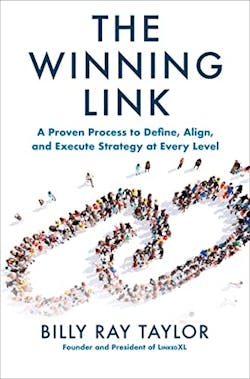‘Be Deliberately and Relentlessly Clear’: Lessons from Goodyear and Beyond
The following is an excerpt from the new book The Winning Link: A Proven Process to Define, Align and Execute Strategy at Every Level by Billy Ray Taylor [McGraw-Hill: 2022]. Taylor spent more than 30 years at the Goodyear Tire & Rubber Co., most recently as the head of North American commercial manufacturing.
When people don’t know what they own, they tend to blame others when something goes wrong or expectations aren’t met. Think about taking a teenager’s car keys when the kid misses curfew. The first words out of my teenager’s mouth would have been, “Dad, that’s not fair.” If he didn’t know what he was accountable for, he would blame his parents when things went sideways.
When he missed his curfew, I took the keys. I later came into the kitchen to find him negotiating and debating with his mother. I told him that the standard is the standard; he lost his car keys because of a choice he made. He understood what he owned. As his parent, my job was to hold him to the standard. I know that things happen. Cars break down; friends need rides home. In that case, however, he should have called me or his mother first. Standards are not monuments, but they are the core of consistency. All my children had the same standard when they received a car. I made it very clear what they owned and what their mother and I owned. (We owned the payment, insurance and maintenance.)
Tailor Your Communication to Your Audience
Just like my son, employees need their leaders to be deliberately and relentlessly clear about what each job entails at every level of the organization, as well as about who owns what. I started doing this in my tenure leading the turnaround of a lagging Goodyear union plant in deep-South Tyler, Texas, messaging up and down the ladder about who owns what in every part of the plant’s business strategy.
I learned several things about clarity during my two years in Texas. First, it’s vital to boil the strategy down to actionable items. When I arrived, management was focused on the goal of making a certain amount of profit. That’s fine, but “earn a 10% profit” (for instance) is a key performance indicator, not a key performance action.
Watch an interview with Billy Taylor on the IndustryWeek Book Club.
You can’t “do” a 10% profit; however, you can transform a culture, in part by being very clear as you define both individual and group success. When I do this, I tailor the language to the audience, using different words to arrive at a common meaning.
I remember taking my son to a park in the ‘hood in Dallas to play basketball. Guys I knew from growing up were there and greeted me with high fives and “Yo, B, what’s up?” That’s not how I greet people at the office, where handshakes and “Hello, I’m Billy Taylor” are the norm. But both “Yo, B!” and “Hello, Billy” mean “friendly greetings,” even though they use different words.The financial experts at Goodyear responded when I talked to them bout earnings before interest, taxes, depreciation and amortization, or EBITDA—a common measurement of corporate financial health. The people on the factory floor knew nothing about EBITDA but were fluent in the language of machine settings and tread widths. Figure out the language that your audience uses and adopt that way of communicating as you explain individual and company goals.
Clarity Is a Springboard to Continuous Improvement
When people understand what they own and what you expect of them individually and as a group, they know exactly where they stand. Imagine that I tell you I want you to make 10 tires every day and that those tires need to meet both client specifications and Goodyear’s standards for quality. You don’t need to wonder where you stand with me. If you are making 10 tires a day as described, then you are doing a great job and have nothing to worry about.
A mind that’s free from wonder and worry has bandwith left over to look around and see what could be better. Workers who got good at consistently making their tire quotas every day started to think that maybe their jobs would be easier if they moved their tools closer to their workbenches. They might be able to make an extra tire every now and then if they didn’t have to wait for materials to arrive from the central storage point. Having two people reset two machines might be faster and more accurate than having each person reset one machine.
That kind of creativity is exactly what you want. There’s no way that I, or any other manager, can know every detail of every job in a factory. You can’t be everywhere, pointing out instances where a change would be an improvement. As a group, individual workers can. Once you’ve shown them that continuous improvement benefits everyone, your message goes viral.
Every key performance action is performed by an individual, and improvements happen because individual workers practice the actions that, taken together, move the key performance indicators. When you break down individual job components, workers can see additional actions they could take that would improve performance even more.
They take ownership of those actions and they’re no longer cogs in a machine, subject to the whims of people above them and with no real interest in how the things they do contribute to the company’s success or failure. Individual workers are genuine CEOs of the portion of the business that stands before them, and they can see how regular, consistent effort creates measurable change.
There’s probably no need to measure every key performance action unless measurement is an important part of getting the action right. (I’m imagining a mixture that needs to be cooked at a precise temperature, or a surface that needs to be hit at an exact 45-degree angle.) Giving feedback on key performance actions can be helpful, though, as long as it’s presented as encouragement and neutral information. No one in the midst of learning new things needs extra stress or criticism.
Give people the support they need to do new things well, including time to learn and practice, and avoid assigning blame. Individual blame leads to hesitation, withdrawal and holding back—exactly the behavior that we want to reduce as we move people toward feeling more engaged, empowered and responsible.
Billy Taylor is the CEO of LinkedXL, a business operating systems architecting firm dedicated to implementing effective operating systems that drive sustainable results. Previously, he served as the head of North American commercial manufacturing and chief diversity and inclusion officer for Goodyear. His work at Goodyear’s plant in Lawton, Oklahoma, helped his team win the Shingo Prize Silver Medallion for Operational Excellence.






